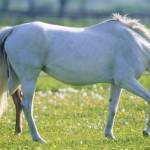Nourishing Thin Broodmares for Foaling and Lactation

Most broodmares should be maintained in moderate to moderately fleshy body condition throughout gestation. While there may be a reasonable explanation for a drop in body condition, mares with suboptimal nutrition may become too thin as feed resources dwindle and fetal growth accelerates. When presented with a thin mare in late pregnancy, what’s the best option to achieve a higher plane of nutrition? Kathleen Crandell, Ph.D., and Catherine Whitehouse, M.S., both nutrition advisors with Kentucky Equine Research (KER), provide help for one mare’s owner.
I just bought a nine-year-old American Saddlebred mare to remove her from a neglectful situation. Based on what I can piece together, she has had multiple foals in the past and is currently at least nine months pregnant. She has sustained herself on low-end hay throughout the winter. The owner was unable to provide a veterinary history. What’s the safest way for me to increase the quality and quantity of her diet?
Without question, the mare’s diet must be improved in an attempt to meet the nutritional requirements for late pregnancy and lactation, and to ensure the delivery of a healthy foal. Before addressing the diet, the mare should be thoroughly examined by a veterinarian. Be sure to reveal all of the details you’re in possession of, though they seem to be few. The veterinarian will likely be interested in doing a fecal egg count to determine parasite load and then recommend an appropriate deworming protocol. Many of the deworming products on the market are safe for late-pregnant broodmares, but double-check packaging before dosing. Suitable vaccinations can also be given. Further, an inventory of the mare’s teeth should be done by the veterinarian or a competent dental specialist with special attention given to sharp edges, loose teeth, or malalignments.
“When managed conscientiously, American Saddlebreds are typically easy keepers, so I have a feeling that this mare will turn around with appropriate care and nutrition if given sufficient time,” said Crandell. “The effect of the mare’s poor nutrition on her fetus is difficult to determine. Mares, like many other mammals, will often give everything they can from a physiological perspective to maintain pregnancy. With two months left in her gestation, improved nutrition will help put her in a stronger state for foaling and lactation.”
Forage is an oft-forgotten source of calories, so an upgrade in forage is the most natural place to begin this mare’s restorative diet. In instances such as this, any well-cured hay harvested at early maturity is suitable, though alfalfa (lucerne) or an alfalfa-mix will provide more calories than grass hay of the same quality. Try to have some forage in front of the mare at all times, as this will provide her with a constant source of energy and will keep her gastrointestinal tract functioning optimally.
Introduction of a concentrate can begin once the mare has been accustomed to the new forage for several days. Assuming her teeth are sound, she can be fed a concentrate intended for pregnant mares. “Gradually increase the amount of concentrate, following the recommendations provided by the manufacturer. In time, it would not be unusual for a mare such as this to be eating 8-10 lb (4.0-4.5 kg) of concentrate per day, split into two or three meals,” suggested Crandell.
Once she’s comfortable consuming this ration, which will likely be a few weeks into the refeeding campaign, a high-fat supplement can be added to the ration. Vegetable oil (canola or soybean) and stabilized rice bran are two calorie-rich supplements. Vegetable oil is typically fed at 1-2 cups (250-500 ml) per day, and stabilized rice bran at 1-2 lb (0.45-0.9 kg) daily.
If there are dental problems that preclude normal chewing, a pelleted feed might have to be moistened thoroughly and offered. These types of mashes are especially useful for horses that cannot thoroughly break down the ingredients in typical textured feeds.
Access to fresh water and a salt block round out a balanced diet.
To increase this mare’s likelihood of having a healthy foal with strong immunity as well as suitable milk production, consider feeding her a marine-derived source of omega-3 fatty acids. Multiple reproductive benefits have been shown in breeding horses fed omega-3s, including improved colostrum quality and enhanced passive transfer of antibodies. “The most biological active omega-3s are docosahexaenoic acid (DHA) and eicosapentaenoic acid (EPA), and these are known to help horses with inflammatory and immune-related responses,” said Whitehouse. One effective marine-derived source of DHA and EPA is EO•3.
Achieving weight gain in late pregnancy is difficult for some skinny mares because so many of the calories consumed are being diverted to fetal growth. Mares often back away from feed as the burden of pregnancy increases and foaling nears. This is not ideal for thin mares, but as long as free-choice, high-quality forage is provided, there is not much else that can be done. Appetite usually picks up once mares foal.








